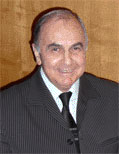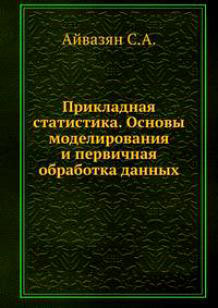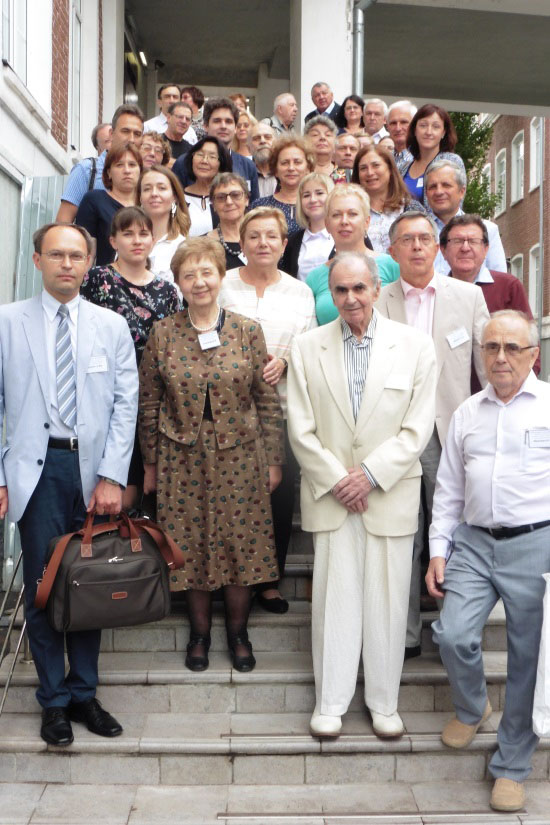Aivazian Sergey artemievich: Memories of a colleague
Figure 1.
Professor Aivazian.

Professor Sergey Aivazian is an outstanding Soviet and Russian scientist in the domain of theoretical and applied econometrics, multivariate statistical analysis, probabilistic and statistical modeling of social and economic real-world processes. Latter include measuring and studying of latent (synthetic) categories of population life quality, research of allocations and redistributions within the society, international and interregional econometric analysis. He is the author and coauthor of above 350 academic publications of which there are nine books.
Sergey Aivazian was born in Moscow on June 24, 1934. His farther Artemyi Aivazian was a distinguished musician, the founder and leader of the first USSR jazz-orchestra “Armenia”. In 1952 Aivazian finished Moscow school No. 186 with the gold medal. In 1957 he graduated from the mechanics and mathematics department of the M.V. Lomonosov Moscow State University (MSU). Russian academician (one of the highest positions within the USSR Academy of Sciences hierarchy) A.N. Kolmogorov was his diploma scientific supervisor. During the period of 1957 to 1969 Aivazian worked as a junior research fellow within the V.A. Steklov Mathematics Institution of the USSR Academy of Sciences. In 1967 he successfully presented his PhD thesis under the supervision of the academician Yu.V. Prokhorov. He then obtained the degree of the candidate of physics and mathematics sciences (the first out of two stage-degree system in the USSR and Russia today).
In 1969 he changed his job to the Central Economics and Mathematics Institution (CEMI) of the Academy of Sciences. He arranged the laboratory of the probabilistic and statistical methods and models for the economics studies. Then he became the head of the larger Econometrics and applied statistics department that encompassed the laboratory. In 1985 he was assigned deputy institution director responsible for the research.
In 1975 Aivazian successfully presented his doctoral thesis to obtain the second-level scientific degree, i.e. he became doctor of the physics and mathematics sciences, particularly for the domain No. 01.01.09 “Mathematical cybernetics”. In 1976 he received the professorship status (the USSR and Russian academic system differentiates the professor as a rank (status) and as a job position, e.g. within the educational establishments). In 2008 Aivazian was elected the foreign member of the Armenia Republic National academy of sciences within the mathematics domain.
We would like to underline the vast academic management and educational activities of professor Aivazian. Namely, he was:
• Head of the CEMI econometrics and applied statistics department, as well as the head of the CEMI laboratory for the probabilistic and statistical methods and model for economic studies;
• Head of the econometrics and economy-applied mathematical methods department within the MSU Moscow School of Economics (MSE);
• Head of the econometrics department of the Moscow financial and industrial academy (latter – university);
• Chair of the thesis committee No. D-002.013.02 for the presentation of both level thesis within physics and mathematics domain within CEMI;
• Academic chair of the regular workshop “Multivariate statistical analysis and probabilistic modeling of real-life processes” (MSE);
• Member of the editorial board for the journal “Probability theory and applications” (the journal was launched in 1956 by academician A.N. Kolmogorov and is issued by the V.A. Steklov Mathematics Institution);
• Professor of the National Research university “Higher School of Economics”;
• Professor of the Moscow state university of economics, statistics and informatics (MESI);
• Invited professor of the Economics and mathematics institute of the Dijon university (France, 1980); Royal Holloway London University (1996–1998), Geneva university (2007–2012).
In 2006 Professor Aivazian launched the new academic journal “Applied Econometrics” (Synergie Press, Russia). It soon became one of Top-3 (Top-5) Russian leading journals within the economics domain. It is also well recognized compared to other Russian journals within international citation databases.
Figure 2.
Applied statistics and basics of econometrics (1998) [in Russian].
![Applied statistics and basics of econometrics (1998) [in Russian].](https://content.iospress.com:443/media/mas/2020/15-4/mas-15-4-mas200501/mas-15-mas200501-g002.jpg)
The findings of professor Aivazian were noticed within Russia, as well as internationally. WE may judge about this due to numerous translations of his books in France, the Great Britain, Switzerland, Austria, Czech Republic, Poland, as well as by his long list of conference presentations at the large international conferences held in the USA, the Great Britain, France, Switzerland, Canada, Italy and other countries.
Professor Aivazian focused much on the econometric studies of the quality of life analysis and modeling, allocative and redistribution relationships within the society at the international and interregional levels.
Figure 3.
Methods of econometrics (2010) [in Russian].
![Methods of econometrics (2010) [in Russian].](https://content.iospress.com:443/media/mas/2020/15-4/mas-15-4-mas200501/mas-15-mas200501-g003.jpg)
His first book “Statistical study of dependencies” (1968) that was published in 1970 in French PhD students of 1970s learned. In 1983–1989 the book “Applied statistics” appeared in three volumes. It was jointly prepared by Aivazian et al.. It is friendly called ‘a legendary three-volume black book on statistics’. It became the undisputable guidance for generations of Russian statisticians. To our surprise, though to an expected one, mostly 40 years after its publication we found it within personal collections of the Bank of Russia experienced employees. They recall how they parents bough that three-volume book and were eagerly waiting the publication of each new book by professor Aivazian.
Figure 4.
Econometrics (2007) [in Russian]. Professor Aivazian on the cover page.
![Econometrics (2007) [in Russian]. Professor Aivazian on the cover page.](https://content.iospress.com:443/media/mas/2020/15-4/mas-15-4-mas200501/mas-15-mas200501-g004.jpg)
In 1992 professor Aivazian developed the founding principles and the concept of the modern econometric teaching. He develops syllabus and is the first one to deliver lectures on econometrics, multivariate statistical analysis, econometric modeling within MSU and MESI. In 1998 the first textbook “Applied statistics and basics of econometrics” was published in coauthorship with V.S. Mkhitaryan. Later in 1999 it was awarded as the best textbook in TACIS series (a special EU program for Technical Assistance for the Commonwealth of Independent States). Professor Aivazian was the number one in the world to suggest that econometric tools should be enriched by that of multivariate statistical analysis, e.g. cluster-analysis, principal components analysis, multidimensional scaling. Nowadays with the growth of popularity of machine learning techniques there is unlikely a person who may expect data research without these latter tools.
As an extension, professor Aivazian published another textbooks called “Basics of econometrics” (2001), “Methods of econometrics” (2010), “Econometrics 2” (2014).
Figure 5.
Quality of Life and Living Standards Analysis (2016) [in English].
![Quality of Life and Living Standards Analysis (2016) [in English].](https://content.iospress.com:443/media/mas/2020/15-4/mas-15-4-mas200501/mas-15-mas200501-g005.jpg)
Figure 6.
Quality of Life and Living Standards Analysis: An Econometric Approach†(2012) [in Russian].
![Quality of Life and Living Standards Analysis: An Econometric Approach†(2012) [in Russian].](https://content.iospress.com:443/media/mas/2020/15-4/mas-15-4-mas200501/mas-15-mas200501-g006.jpg)
One of his latter book “Quality of Life and Living Standards Analysis: An Econometric Approach” (2012) that joins his findings since 1970s was published in English in 2016 (https://www.amazon.com/s?k=Quality-Life-Living-Standards-Analysis). One of his key novelties is the introduction of methodology of aggregate indexes composition. Such indexes measure the synthetic latent categories of life quality. They minimize the information loss that occurs during the transit from the large-space multivariate universe to a significantly reduced one. He also introduced novel approaches to household consumer patterns classification. He was able to reconstruct the household target utility functions based on household budget spending statistics. His models accurately describe household distributions by wages (salaries). His special studies cover the household distribution by average spending amounts and by average monetary savings.
Figure 7.
Econometrics using STATA (2016) [in Russian].
![Econometrics using STATA (2016) [in Russian].](https://content.iospress.com:443/media/mas/2020/15-4/mas-15-4-mas200501/mas-15-mas200501-g007.jpg)
There is also a long list of books published under his translation and editorship. A last book in a series is “Econometrics using STATA” (Urait, 2016). We had the pleasure of collaborating with him on the project. Though it seemed to be an ordinary econometric textbook translation project, it took us mostly eight years to undertake since H. Penikas first heard of it from professor Aivazian in 2008, till they started finalizing it in 2012. It took several years to negotiate copyright with the Stata Press, its holder. Thus, professor Aivazian helped to demonstrate the full variety of the academic world as science and research is not only a wonderful world of imagining research hypothesis, thinking of unprecedented research objectives, but it is also quite a routine process that needs ability to work in a regular (often monotonic way by comparing letter by letter in the original book and in the translated version).
Professor Aivazian contributed a lot to introduction and development of multivariate statistical analysis and econometrics when teaching economics and supervising social and economic research within Russian universities. We consider that to a large extent his regularly run workshops and conferences contributed to such a success. Particularly, since 1977 he regularly held once in four years international conferences “Application of multivariate analysis to economics and quality of life measurement” (XI-th such conference took place in Moscow in 2018). He similarly ran once in four years a summer school “Multivariate statistics and econometrics” (IX-th was held in the Tsakhkadzor town, 56 km near to the Armenia Republic capital of Yerevan, in 2016). This conferences and professor Aivazian’s books help to breed several generations of Russian university teachers of applied statistics and econometrics.
Professor Aivazian was able to transfer his skills and knowledge of econometrics and multivariate statistical analysis (MSA) to many students and PhD students. For instance, they are Marina Kruglyak from the Moscow School of Economics (MSE), Elena Vakulenko from the Higher School of Economics (HSE), Maria Volkova (CEMI), Alexander Kudrov from HSE and CEMI, Henry Penikas (HSE). All of them always remember professor S. Aivazian with kindness and tenderly preserve the memory about their Teacher. The astonishing and capturing personality of professor Aivazian was a live example for them that science in modern post-transitional Russia can be inspiring, interesting and enjoyable. All of them are active researchers today and regularly publish papers using econometric and MSA tools.
Figure 8.
Applied statistics. Volume 1: Basics of modeling and preliminary data preparation. Moscow, Finance and statistics, 1983 (translated in French).

Figure 9.
Social Indicators (2006) [in Russian].
![Social Indicators (2006) [in Russian].](https://content.iospress.com:443/media/mas/2020/15-4/mas-15-4-mas200501/mas-15-mas200501-g009.jpg)
Major research findings of professor Aivazian:
• He compared optimal properties of the conventional Neumann-Pearson criteria and the consecutive Wald one when one wished to differentiate hypothesis about the type of distribution. He deducted asymptotical formulas for the mean number of observations (when hypothesis collide) to differentiate such hypothesis given the predefined values of the first and second type errors (1959–1965).
• He has proven together with Yu.A. Rozanov the asymptotical efficiency of the OLS regression coefficient estimates given the very general nature of model residuals codependence (1964).
• He introduced the expert and statistical approach to derive the unkonwon target (objective) function given different types of training expert data (1974).
• He developed a system of models to describe the mechanisms of the allocative relationships formation within a society. He also suggested approaches for such models identification (1976).
• Together with N.M. Rimashevskaya he studied the consumer typology. He justified approaches how to empirically reveal major consumer types and define major typological socio-demographic and territorial features (1978).
• Together with V.M. Buchshtaber he justified general theory of automatic classification. The whole universe of approaches to cluster-analysis became clearly structures in a hierarchical form (1986–1989).
• He introduced the parametric cluster-analysis. It is based on the mixture of normal distributions and the procedure of multivariate data target projecting (1996).
• He modeled the mechanism of the Russian population distribution by the amount of per person spending during the economy in transit when the classical lognormal model is transformed in a mixture of lognormal distributions. This tool helped to study poverty and population differentiation by spending in 1990s. Namely, he preferred observing any distribution as a mixture of a set of normal (Gaussian) one. Such an approach enabled vividly describe 1990s tendencies in the Russian economy as particular distributions out of the pre-1991 set (prior to the USSR collapse) evaporated implying to a bi-hump (largely unequal) income distribution. (2000–2001).
• He developed the methodology to measure the latent synthetic quality and mode of life indexes. The approach advantage is that it does not need subjective (expert) weights for the important of the components within the synthetic index (1997–2017).
Professor Aivazian was able to work so hard due to his sports engagements, specifically tennis and football. During 30 years after graduating from the university he was his university-year football team lead when playing with other university-mates’ teams. He was also regularly practicing tennis at least twice a week, even bringing his tennis rocket to Tsakhkadzor conference.
We remember Aivazian as a leader who was able to form a team of like-minded people. Authors are proud being part of such a team for many years.
Professional awards:
USSR Council of Ministers Award laureate (1986) for the works in the area of multivariate statistical analysis and its applications;
Medal of the French national statistical congress (1986);
European econometric society medal (1988);
Fedorenko international scientific fund of economic research award for the outstanding contribution to the development of economic science in Russia (2007);
Order for enlightenment contribution (2009);
Medal to the Order of Motherland desert of the 2
Kantorovich award of the Economics Department of the Russian Academy of Science for the outstanding works within the area of economic and mathematical models and methods (2017).
Professor Aivazian Book:
1. Aivazian S.A. Statistical study of dependencies. Moscow, Mettalurgy, 1968 (translated and published in French in 1970 and 1978).
2. Aivazian S.A., Bezhaeva Z.I., Staroverov O.V. Classification of multivariate observations. Moscow, Statistics. 1974 (translated in Czech).
3. Aivazian S.A., Rimashevskaya N.M. Consumer typology. Moscow, Science. 1978.
4. Aivazian S.A., Yenuykov I.S., Meshalkin L.D. Applied statistics. Volume 1: Basics of modeling and preliminary data preparation. Moscow, Finance and statistics, 1983 (translated in French).
5. Aivazian S.A., Yenuykov I.S., Meshalkin L.D. Applied statistics. Volume 2: Research of dependencies. Moscow, Finance and statistics, 1985.
6. Aivazian S.A., Yenuykov I.S., Meshalkin L.D. Applied statistics. Volume 3: Classification and dimension reduction. Moscow, Finance and statistics, 1989.
7. Aivazian S.A., Mkhitaryan V.S. Applied statistics and basics of econometrics. Moscow, Unity. 1998.
8. Aivazian S.A., Mkhitaryan V.S. Applied statistics and basics of econometrics. Volume 1: Theory of probability and applied statistics. Moscow, Unity. 2001.
9. Aivazian S.A., Mkhitaryan V.S. Applied statistics and basics of econometrics. Volume 2: Basics of econometrics. Moscow, Unity. 2001.
10. Aivazian S.A., Mkhitaryan V.S. Applied statistics and basics of econometrics. Volume 3: Applied statistics in exercises and problems. Moscow, Unity. 2001.
11. Borodkin F.M., Aivazian S.A. Social Indicators. Moscow, Unity. 2006.
12. Aivazian S.A., Ivanova S.S. Econometrics, Market DS. 2007.
13. Aivazian S.A. Analysis of the population quality and mode of life. Moscow, science. 2012 (translated in English in 2016).
14. Aivazian S.A. Methods of econometrics. Moscow, Magistr, Infra-M. 2010.
15. Aivazian S.A., Fantazzini D. Econometrics 2. Advanced course with finance applications. Moscow, Magistr, Infra-M. 2014.
Figure 10.
I-st conference “Application of multivariate statistical analysis in economics and life quality measurement” (Moscow, 2018).In the centre of the front row on the photo there are professor I. Eliseeva (to the left) and professor S. Aivazian (to the right).





